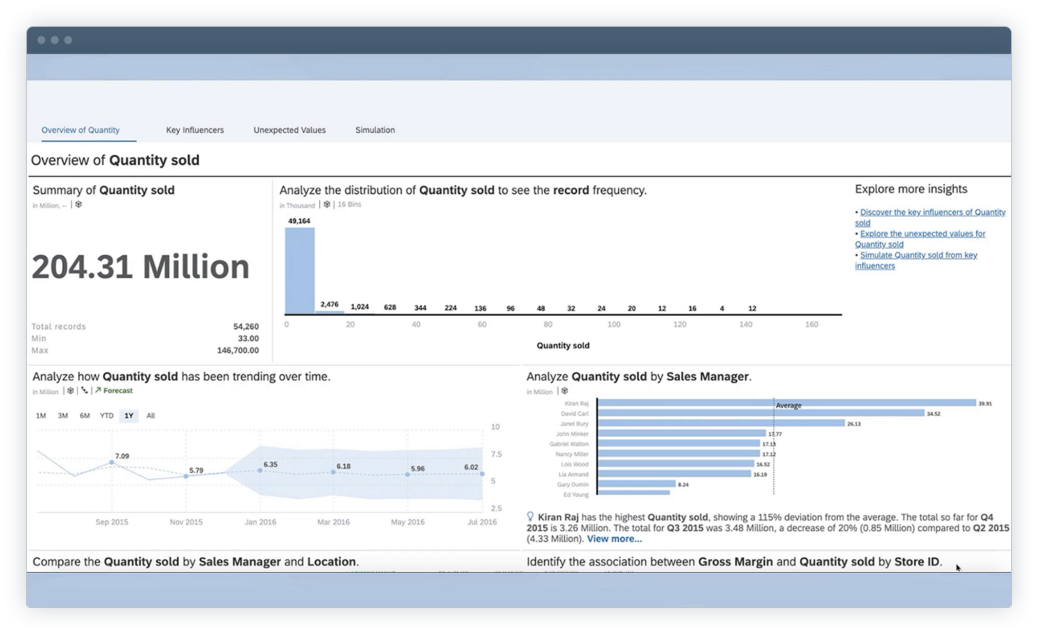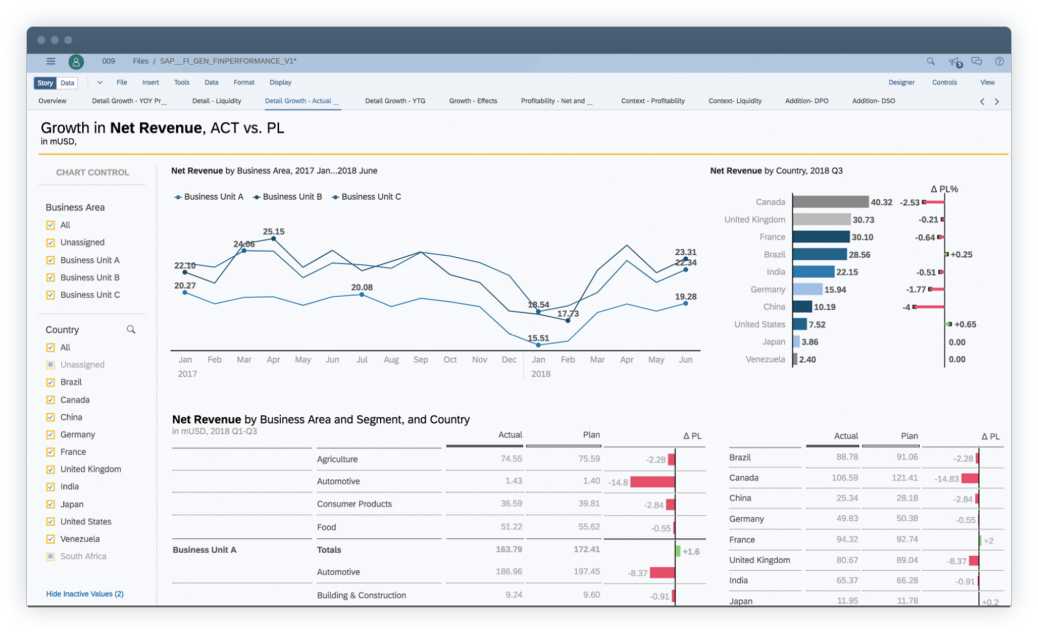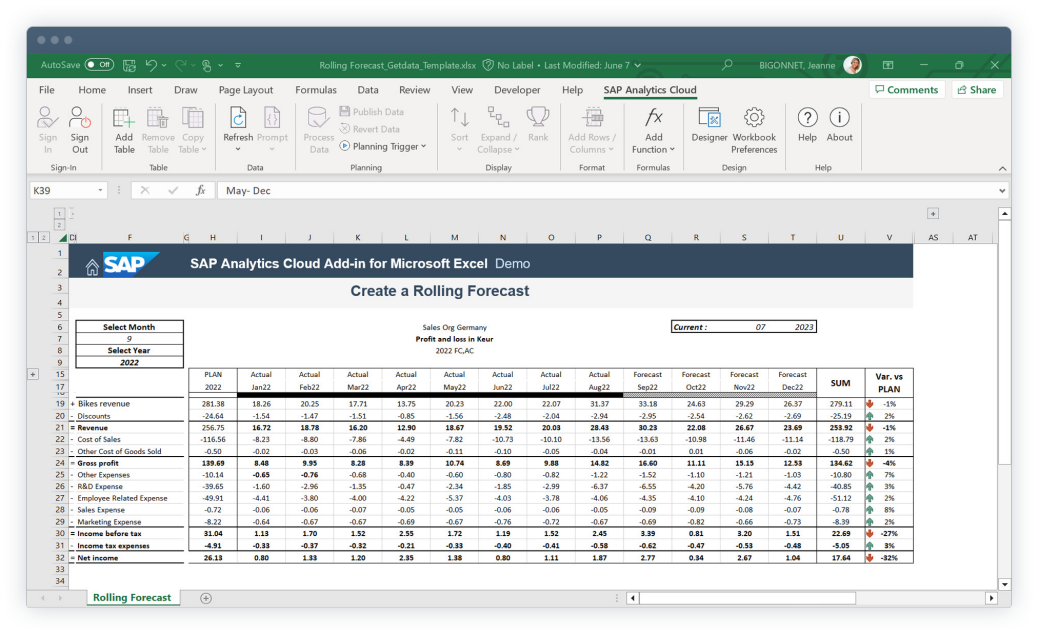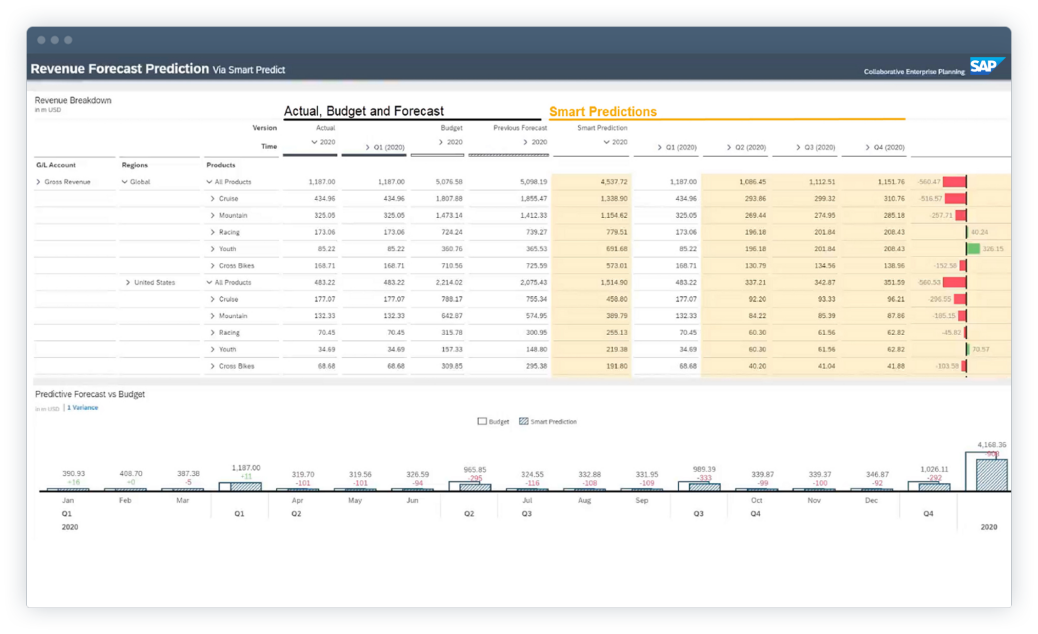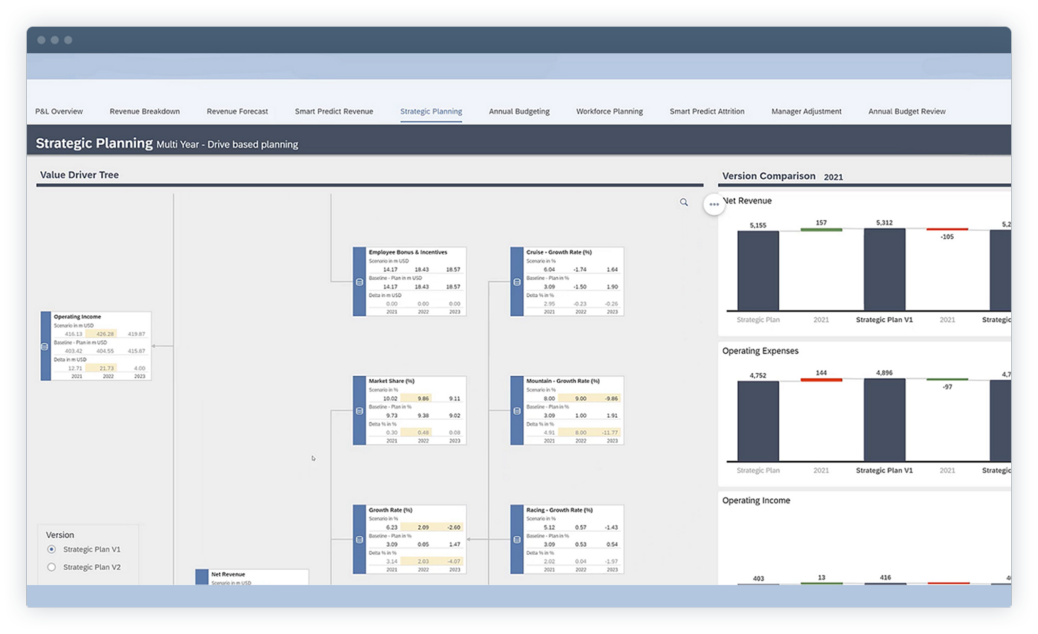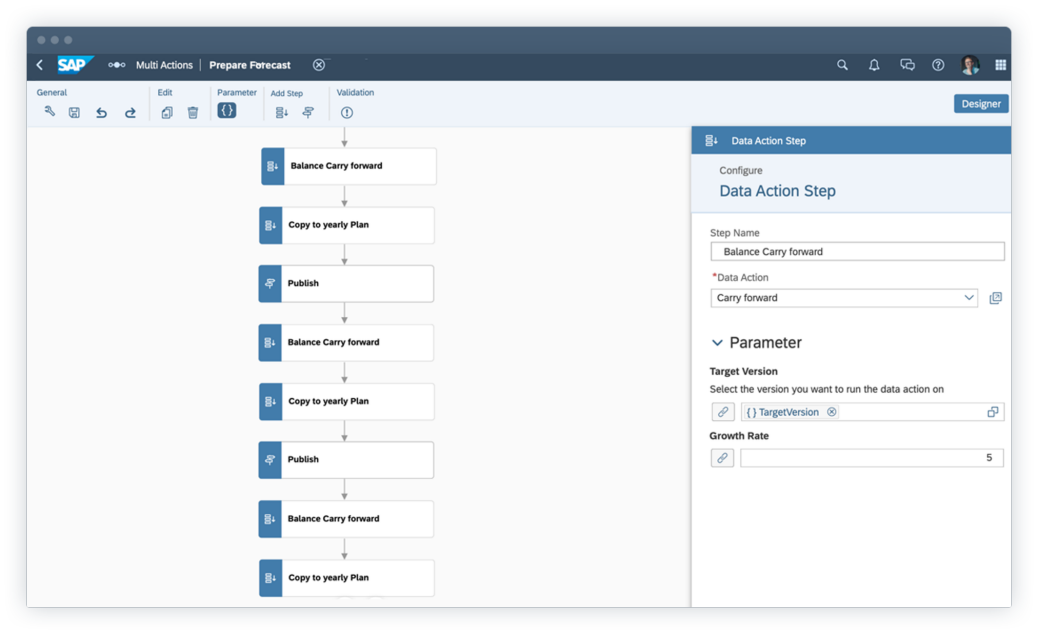Pavel Ramanouski, Head of SAP BI and EPM practice at ACBaltica.
SAP Analytics Cloud (SAC) and SAP Business Planning and Consolidation (BPC) are known for their robust planning capabilities. This blog post breaks down the key features, benefits, and differences between these two powerful SAP solutions, helping you determine which tool best suits your business needs. Read on to discover which platform will enhance your planning capabilities and drive your business forward.
Being a global leader in enterprise software, SAP has been empowering businesses to optimize their operations, drive innovation, and achieve sustainable growth for decades. Among its offerings, SAP has developed advanced tools tailored to meet the diverse planning needs of organizations, regardless of their size or industry. Two key products in SAP’s portfolio, SAP Analytics Cloud (SAC) and SAP Business Planning and Consolidation (BPC) stand out as powerful solutions for financial planning, budgeting, and forecasting. This article explores the strengths and applications of SAP SAC and SAP BPC, helping businesses determine which tool best aligns with their specific requirements and circumstances.
SAP Business Planning and Consolidation
SAP Business Planning and Consolidation (BPC) is a versatile solution that combines planning, budgeting, and financial consolidation into one platform. It's designed to help businesses streamline their financial processes, reduce the time spent on closing and reporting, and ensure everything aligns with regulatory standards. By automating key tasks and giving users real-time access to data, SAP BPC makes it easier for teams to collaborate and keep plans aligned with the company’s goals. Whether deployed in the cloud or on-premise, this solution offers the flexibility to meet different business needs, enabling organizations to stay agile, make better decisions, and achieve their financial targets efficiently.
Key features and capabilities of SAP BPC
-
Planning. SAP BPC offers robust planning capabilities that help businesses develop and manage strategic, financial, and operational plans. It allows for top-down and bottom-up planning approaches, enabling companies to align their resources with long-term goals. The platform facilitates collaboration across departments, ensuring all plans are integrated and aligned with the overall business strategy.
-
Budgeting. SAP BPC's budgeting feature streamlines the process of creating and managing budgets across the organization. It provides tools for setting and tracking budget targets, allowing businesses to allocate resources efficiently. With its real-time data integration, SAP BPC ensures that budgets are based on the most current financial information, helping companies stay on track financially.
-
Forecasting. The solution improves forecasting by enabling rolling forecasts, which help businesses extend their projections 12-18 months or further into the future. It combines actual and forecast data into a single version, simplifying reporting and analysis. Moreover, SAP BPC’s what-if analysis and scenario planning features allow for real-time evaluations and rapid adjustments, ensuring that businesses can swiftly adapt to changing circumstances and make well-informed decisions.
-
Consolidation. SAP BPC simplifies the financial consolidation process, making it easier for companies to combine financial data from multiple entities, various sources and ERP solutions (including S/4HANA and non-SAP applications). It automates complex tasks such as intercompany eliminations and currency conversions, ensuring consolidated financial statements are accurate and compliant with regulatory standards. This reduces the time and effort required to close the books and prepare financial reports.
-
Legal and management reporting and analyses. The solution provides comprehensive reporting and analysis tools for legal and management needs. It enables businesses to generate accurate financial statements, compliance reports, and custom management reports. The platform’s advanced analytics capabilities help organizations gain deeper insights into their financial performance, supporting better decision-making.
-
Scalability and flexibility. SAP BPC is designed to grow with your business, offering scalability to meet the needs of both mid-sized companies and large enterprises. The platform supports flexible deployment options, including cloud, on-premise, or hybrid environments, allowing businesses to choose the setup that best fits their infrastructure and operational requirements. This adaptability ensures that SAP BPC can evolve with your business as it expands and changes.
Benefits of SAP BPC
SAP Business Planning and Consolidation (BPC) offers robust functionality for integrated financial planning, budgeting, forecasting, and consolidation, making it ideal for organizations seeking a unified platform for managing both planning and financial close processes. BPC is particularly beneficial for its deep integration with SAP ERP systems and its ability to handle complex, multidimensional data models and hierarchical structures, which are essential for accurate financial consolidation. One distinct advantage of BPC over SAP Analytics Cloud (SAC) is its on-premise deployment option, providing greater control over data security and compliance for organizations with stringent regulatory requirements. Additionally, BPC's strong Excel integration allows finance teams to leverage familiar tools while working within the platform, facilitating user adoption and productivity.
SAP Analytics Cloud
SAP Analytics Cloud (SAC) is a powerful tool that combines Business Intelligence, Analytics, and Planning in one place, helping businesses make smarter decisions using their data. One of its standout features is predictive analytics, which allows companies to forecast future trends and outcomes, making their planning more accurate and proactive. SAC is great for businesses that need flexible and real-time planning, allowing teams to work together easily and adjust quickly as data changes. It connects smoothly with SAP and third-party systems, making it easy to combine data from different sources. Overall, SAC is ideal for companies looking to improve decision-making, collaboration, and scalability while keeping their data secure and compliant.
Key features and capabilities of SAP Analytics Cloud
-
Integrated planning and budgeting. SAC allows for seamless integration of financial, operational, and strategic planning in a single platform, enabling comprehensive budgeting, forecasting, and what-if analysis.
-
Predictive Analytics. SAC’s predictive analytics tools enhance planning accuracy by forecasting future trends based on historical data, enabling proactive and informed decision-making.
-
Real-time data connectivity. With live connections to SAP and non-SAP systems, SAC ensures that planning is always based on up-to-date information, allowing for timely adjustments.
-
Collaboration and workflow management. SAC supports collaborative planning, allowing multiple users to contribute, share insights, and track progress, ensuring alignment across teams.
-
Advanced visualizations and dashboards. SAC provides powerful visualization tools and customizable dashboards, making it easy to interpret, communicate, and act on planning data in real time.
-
Embedded analytics. SAP Analytics Cloud enables organizations to embed interactive dashboards and reports directly into their existing applications, improving user experience and promoting data-driven decision-making across all levels of the organization.
Benefits of SAP Analytics Cloud for planning
A truly powerful tool for analytics and planning, SAC has some unique features for planning purposes. Its predictive analytics lets businesses forecast trends and outcomes precisely, enabling more informed and proactive decisions. The cloud-based platform provides flexibility and scalability, allowing companies to adapt quickly as their needs change without the constraints of on-premise systems. Real-time data connectivity ensures that planning is always based on the most current information, which is essential for making timely decisions. Plus, SAC's ability to embed analytics directly into business applications enhances user experience, making it easier for teams to use data-driven insights in their everyday work.
SAP BPC via SAP Analytics Cloud: Key differences for planning purposes
In this chapter, we compare SAP BPC and SAP Analytics Cloud (SAC), focusing on their architecture, integration capability, interface, and more.
Architecture and Deployment
SAP BPC is primarily an on-premise solution, although it does have cloud-based versions, such as BPC optimized for S/4HANA. Meanwhile, it is traditionally installed on an organization's servers, offering complete control over the infrastructure. With all bonuses for security management, this approach can lead to higher maintenance costs and longer implementation times.
SAP Analytics Cloud is a purely cloud-based solution, meaning it is hosted on SAP's servers. This allows for faster deployment, easier scalability, seamless updates, and minimal IT involvement. The cloud-based nature of SAC is ideal for companies looking for agility and lower upfront costs. However, it may raise concerns for businesses that prefer on-premise control and entirely predictable costs (which may not be available with cloud deployment).
Planning and forecasting capabilities
Both solutions offer robust planning and forecasting capabilities. However, SAP BPC focuses on financial planning, consolidation, and budgeting. It excels in complex financial scenarios and provides strong integration with Microsoft Excel, which many finance teams prefer for detailed planning activities.
SAP Analytics Cloud, on the other hand, combines planning, analytics, and predictive capabilities in one platform. While it may not match BPC's depth in financial consolidation, it offers a more flexible and modern approach to planning across various business functions.
SAC offers more advanced features like machine learning-based forecasting, allowing for dynamic and automated predictions.
Integration with other SAP solutions
SAP BPC is deeply integrated with SAP ERP systems, particularly SAP S/4HANA, and it offers strong integration with SAP BW (Business Warehouse). This makes it a powerful tool for organizations already heavily invested in SAP's ecosystem.
SAP Analytics Cloud, on the other hand, offers integration not only with SAP solutions (SAP S/4HANA, SAP BW, SAP SuccessFactors) but also with third-party data sources. SAC’s cloud-based nature facilitates easier integration with cloud-based tools and platforms, making it more versatile in hybrid environments.
User experience and interface
SAP BPC has a more traditional interface, often relying on Microsoft Excel for user interactions. This approach can be familiar but somewhat dated in terms of user experience. This feature, advantageous for finance teams accustomed to Excel, may be less appealing to those seeking a modern, intuitive UI.
SAP Analytics Cloud offers a sleek, modern, and user-friendly interface designed with self-service in mind. The SAC interface is highly visual, with drag-and-drop features, interactive dashboards, and a more engaging user experience. This makes SAC particularly appealing to business users and analysts who prefer a more modern and interactive tool.
Analytics and reporting
SAP BPC provides solid reporting capabilities, particularly in the financial domain. It is well-suited for organizations that require detailed financial reports and statutory consolidation. However, its analytics capabilities are more limited compared to SAC.
SAP Analytics Cloud truly shines in analytics and reporting, with powerful features for real-time data visualization, ad-hoc reporting, and advanced analytics. SAC's built-in analytics capabilities allow users to create dynamic, interactive reports that can be easily shared and consumed across the organization.
Collaboration and workflow management
SAP BPC includes built-in workflow management tools, allowing for the automation of planning processes and the assignment of tasks. It also supports collaboration through Excel-based input forms and email notifications. However, collaboration is somewhat limited and can feel fragmented.
SAP Analytics Cloud offers more advanced collaboration features, including real-time commenting, task assignments, and integration with SAP Jam (a collaboration tool from SAP) for social collaboration. SAC’s cloud-based nature enhances collaborative efforts by allowing multiple users to work simultaneously on the same models and reports from any location.
|
Feature |
SAP BPC |
SAP Analytics Cloud (SAC) |
|
Workflow automation |
Strong |
Strong |
|
Real-time collaboration |
Limited |
Advanced |
|
Task management |
Built-in |
Built-in |
Customization and extensibility
SAP BPC is highly customizable, particularly in the on-premise version, allowing organizations to tailor the solution to their specific needs. This includes custom scripts, logic, and processes. However, such customizations can lead to complexity and higher maintenance costs.
SAP Analytics Cloud offers customization through its flexible modeling and scripting capabilities, but due to its cloud-based architecture, it is generally less customizable than BPC. SAC focuses more on simplicity and ease of use, which can be a limitation for highly complex planning scenarios but beneficial for those looking for a more straightforward, agile solution.
Pricing and licensing
SAP BPC typically involves a higher upfront investment due to the need for on-premise hardware, software licenses, and potentially extensive customization. Ongoing costs include maintenance, upgrades, and IT support, making it more suitable for larger enterprises with significant IT resources.
SAP Analytics Cloud operates on a subscription-based pricing model, which can be more cost-effective for organizations looking to manage expenses over time. SAC’s pricing is generally more transparent and predictable, making it appealing to mid-sized companies or those with fluctuating needs. However, the total cost can increase depending on the number of users and additional features required.
SAP Support
It’s not a secret that SAP announced a move into the cloud – and it certainly influenced the vendor support terms for on-premise products. In January 2023, SAP announced an end to mainstream maintenance of BPC version 10.1 for Microsoft in June 2026. The BPC version 10.1 for SAP NetWeaver will be supported until the end of 2027, followed by optional extended maintenance until the end of 2030. The BPC version for SAP BW/4HANA will still be supported until at least 2040. However, times with limited support and product updates will come for BPC sooner than for SAP Analytics Cloud, a next-generation product offering.
Making the Right Choice: SAP BPC or SAC?
Both SAP BPC and SAC have their strengths and are tailored to different business needs. BPC is robust for traditional, in-depth financial planning and will be a great fit for companies with complex financial processes and prefer traditional Excel-based interfaces.
On the other hand, SAC offers a modern, agile solution for integrated planning, analytics, a user-friendly modern interface, and collaboration across the enterprise.
Regarding scalability and future growth, SAC might be a better choice due to its cloud-based nature. This allows businesses to quickly adapt to changes and scale their operations without significant infrastructure changes and hardware investments.
IT infrastructure and resources might also influence your decision. SAP BPC, with an on-premise deployment, requires a robust IT infrastructure and ongoing maintenance. This makes it ideal for organizations with significant IT resources and a need for tight control over data security. SAC, being cloud-based, reduces the burden on IT teams by offering easier deployment, automatic updates, and minimal maintenance.
Given the complexity and importance of this decision, consulting with SAP experts or a trusted partner like ACBaltica can provide valuable insights. We can help you assess which solution aligns best with your business needs, considering factors like integration with existing systems, customization requirements, and long-term goals. We can also guide you through each option's potential challenges and benefits, ensuring you make an informed decision that supports your strategic objectives.


